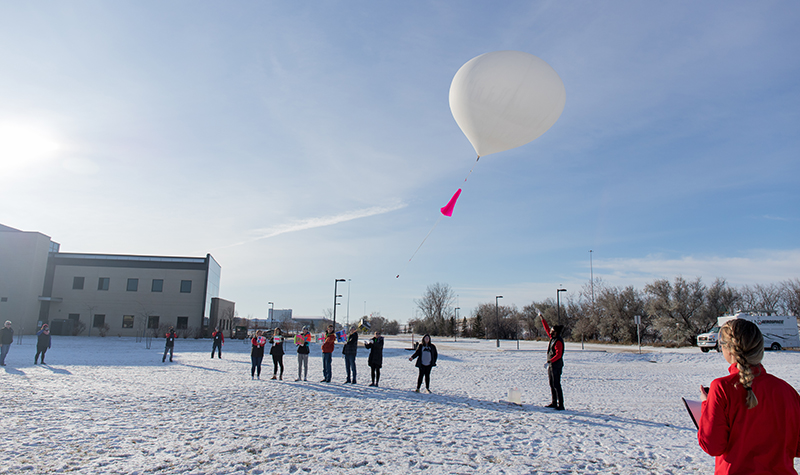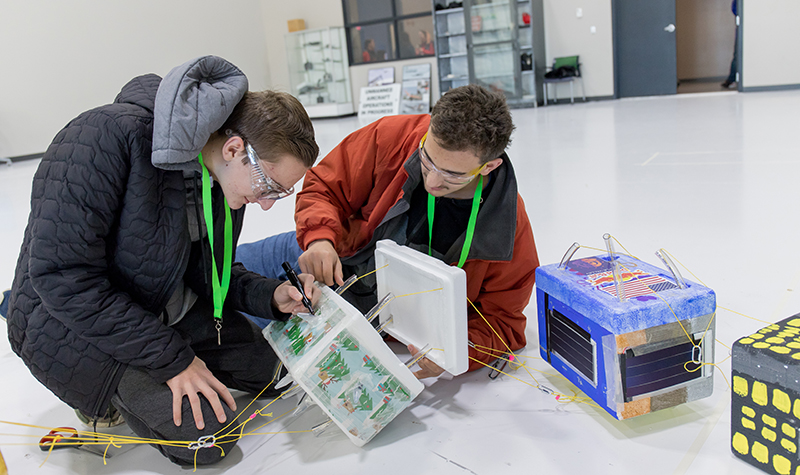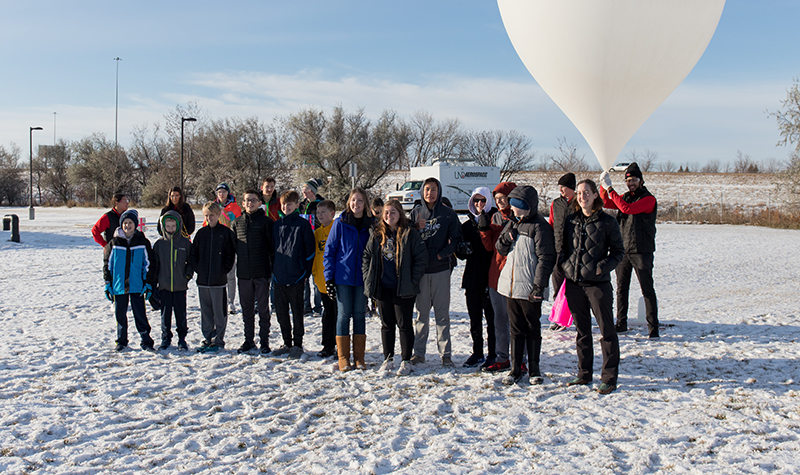07 Dec UND reaching new heights with North Dakota youth
Near-Space Balloon Challenge hosts middle and high school student teams at UND to send experiments miles above Earth

Weather balloons each carrying six research payloads made their ascent Nov. 23 for the ninth annual Near-Space Balloon Challenge. Schools from across the state came to UND for a two-day event culminating in the launch of their teams’ experiments. Photo by Connor Murphy/UND Today.
It can’t be snowing. It can’t be too windy. Ideally, it shouldn’t even be cold, because freezing temperatures complicate things, too.
To launch a weather balloon, conditions need to be right, in other words. That means making the launch in North Dakota in the middle of November is a dicey proposition at best.
And when close to 100 students from around the state are descending on campus to see their weeks and months of hard work — in the form of balloon payloads — ascend through the Earth’s atmosphere, that pumps up the pressure on organizers, too.
But on the weekend of Nov. 22 and 23, sunshine, a breeze and above-zero temperatures meant it was “all systems go” for the Near-Space Balloon Challenge, whose coordinators, UND graduate students and middle and high school students worked together to launch a variety of experiments.
Minds to the Moon
Hosted by the University of North Dakota-based North Dakota Space Grant Consortium (NDSGC), the ballooning challenge funds teams across the state to design, build and present experiments on campus before launching payloads miles above the planet’s surface.
Two balloons launched near Robin Hall on Nov. 23 reached as high as 86,000 feet before popping and sprouting bright pink parachutes to aid their stringed payloads’ descent. The two sets were found close to Gary, Minn. – more than an hour’s drive from the launch site.
Last year, the challenge recognized the 60th anniversary of NASA – the federal agency that funds all 50 states’ (plus the District of Columbia and Puerto Rico) space grant consortia.
“This year’s theme is the 50th anniversary of the moon landing – the Apollo 11 mission,” said Steven Russell, a space studies graduate student from the Twin Cities. “A secondary theme is the new generation of space scientists, space exploration and the Artemis program.”
Considered a sister program to the Apollo missions of the 20th century, Artemis is the 21st century effort by NASA and international partners to send people back to the Moon, and next to Mars.
“So, some groups are looking into how microbes grow in space and how plants grow in space,” Russell continued. “These things are critical to future exploration missions.”
In the words of Marissa Saad, NDSGC coordinator, “it’s Moon-themed, past and future.”

Alex Brinegar (left) and Seth Franchuk, of Langdon, N.D., put the finishing touches on their two-pound payload. In their box, they installed a microcomputer and sensors to measure the temperatures of water samples. Decoration is always encouraged by the Space Grant team. Photo by Connor Murphy/UND Today.
Flexibility to explore
Groups from the nine communities that met the balloon challenge comprised a wide age range, from sixth graders to high school seniors, as happens most years. So, the project’s themes are more about inspiration than strict direction.
Minutes before the morning launches on Nov. 23, a couple of students from the Langdon, N.D., team described what they would be sending to the near-stratosphere .
“Our primary goal is to test how food and fluids will handle a near-space environment,” Langdon Area High School sophomore Alex Brinegar said.

The first balloon, launched. Photo by Connor Murphy/UND Today.
The team would be launching test tubes filled with water, with each water sample holding a different level of salt.
Using a microcomputer called a Raspberry Pi, the team also had assembled a system of sensors capable of measuring temperatures across the assortment of test tubes.
“We’ll measure how cold each will get and whether it will freeze,” Brinegar said. “We’ll also test on the ground to see if at that temperature, it would freeze.”
Brinegar and senior Seth Franchuk said it was their first time participating in the challenge, and they appreciated the support of NDSGC to build what they wanted to test.
“[The challenge] allows us to do a lot more,” Franchuk said. “We have more flexibility with our budget.”
Space Grant’s outreach effort through the challenge covers travel, lodging and other expenses for all of the participating schools every year. The schools’ teams are also reimbursed for their payload construction costs.
“Anything STEM [science, technology, engineering and math] is in demand not just by administrators, but also teachers,” said Saad. When educators realize participating in the challenge doesn’t require many, if any, out-of-pocket expenditures, they’re eager to recruit interested students.
“Not being from North Dakota, I’m always impressed by how teams are driving hours and teachers are volunteering their time to be here,” Saad added.
Saad, with a NASA-stickered megaphone at the ready, led two lines of “payload captains” to the launch site just beyond Robin Hall’s parking lot. Students such as Franchuk held their schools’ experiments as the payload line, beginning with the parachute, was attached to the balloon.
“FIVE, FOUR, THREE, TWO, ONE,” the crowd chanted shortly after.
For this NASA crew, the countdown wasn’t followed by the raucous roar of an engine or the boom of a booster. But there were certainly cheers as the first balloon flew southeast into sunny skies.
The payload captains on the second balloon followed suit – holding their boxes out as if in offering. Since they were aligned with the wind’s direction, the balloon simply lifted the packages from their hands after the second count.

Science teacher Marci Johnson (right) stands with members of her student team for photos just before launching their experiments. Her large crew spanned the challenge’s age range and developed nine experiments for their single box. Photo by Connor Murphy/UND Today.
Seeing the excitement
Marci Johnson was nearby with a camera in-hand. Johnson teaches physics, chemistry and eighth- and ninth-grade science at Shiloh Christian School in Bismarck, N.D., and has brought groups to UND for the past five years.
“I started doing it my first year as a teacher,” she remarked. “I came across how all expenses were covered, and that made it an easy ‘yes’ from the get-go, and the kids enjoyed the project.”
This year she said she had enough students to split into nine mini-groups to create experiments for a two-pound payload. She had sixth, seventh and ninth graders along with seniors.
“The format makes it really accessible to a wide age range because you can have any level of science experiment,” said Johnson. “There are some that are really technically advanced, while one of our groups is sending up a hard-boiled egg to see what happens to it – something that is simple that they can explore and get excited about.”
With the help of one of the seniors, all nine experiments fit in their single box. Johnson said the seniors on the team did a great job working with the younger students to design projects and presentations. All of them learn the scientific method in class, where they form questions and hypotheses; conduct experiments; and derive results. The Near-Space Balloon Challenge works well in replicating that process while creating an environment that excites students and gets them doing science outdoors.
After watching their payloads float away into the blue, students toured around UND’s aerospace buildings to see the Arthur P. Anderson Atmospherium, the Human Spaceflight Laboratory and perspectives from space through Virtual Reality headsets.
“I love seeing them get excited about things,” Johnson said of her student team and their experience at UND. “At the launch, I was taking pictures of their faces as the balloons were released. That’s what keeps me coming back.”


